REGULATORS OF PLANT GROWTH AND DEVELOPMENT – Scientific Achievements
Investigation of the role of growth regulators of synthetic and natural origin and other biologically active substances on the growth and development of plants under optimal and stressful conditions. Study of the natural and induced protective responses of different plant species to abiotic and biotic stressors. Application of newly established or known growth regulators as a means to increase the resistance of economically important plants to adverse environmental conditions such as soil drought, waterlogging, salinization, heavy metal pollution, high and low temperatures, UV radiation, herbicides, phytopathogens and other stresses.
The physiological responses of wheat to soil drought and waterlogging after routine application of the selective herbicide Serrate (Syngenta) were investigated by biochemical, biophysical and molecular biological analyzes. It was found that the application of the herbicide alone does not significantly affect the physiological condition of the plants. Depending on the tolerance of wheat to both types of abiotic stress, typical phenotypic alterations and damages were observed at biochemical and biophysical level. Compared to self-administered abiotic stressors, herbicide treatment and subsequent soil drought did not damage wheat further, while in combination with waterlogging, the physiological disbalance worsen and plants did not recover.
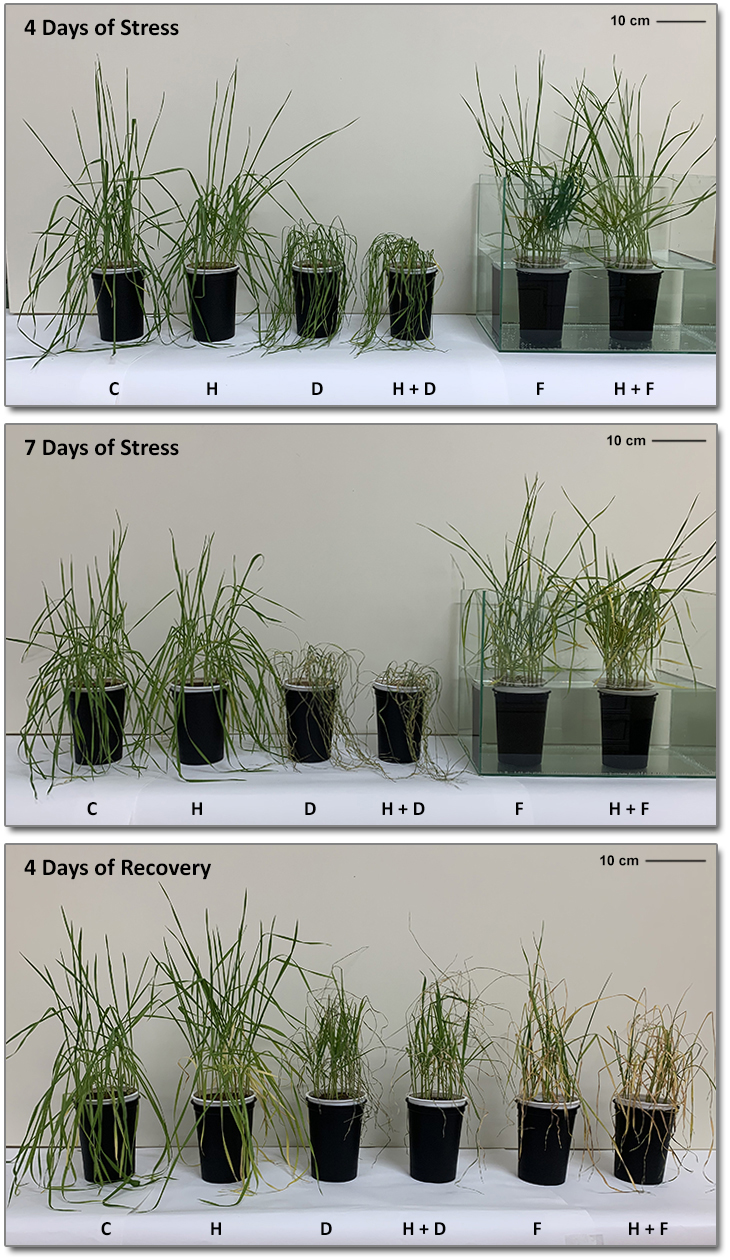
Phenotypic alterations of wheat plants treated with herbicide and subjected to drought or flooding stress. C – Control; H – Herbicide; D – Drought; H+D – Herbicide + Drought; F – Flooding; H+F – Herbicide + Flooding.
Todorova et al. (2021) Plants, 10(4), 733-745
Katerova et al. (2021) Plants, 10(6), 1195-1206
Todorova et al. (2022) Agronomy, 12(2), 390-403
For a first time, a protective effect of two types of synthetic analogues of the plant hormone auxin on the physiological state of pea plants in drought conditions has been established. Under normal growing conditions, the auxin compounds did not significantly change the biometric and biochemical parameters of the plants. Under drought conditions, auxin analogues reduced the negative effects of stress, causing changes in physiological and metabolic processes, which were expressed as lower content of stress biomarkers and improved growth of pea plants. The proven protective effect of the tested compounds is a prerequisite for their potential practical application.
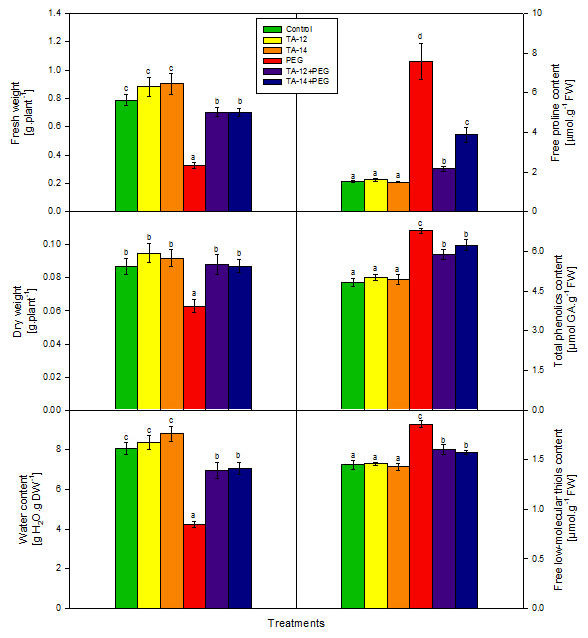
Exogenous auxin type compounds amend PEG-induced physiological responses of pea plants.
Sergiev et al. (2019) Sci. Horticult., 248, 200-205
Pre-treatment with synthetic auxins partially improved the growth of pea plants treated with herbicides. This is accompanied by a reduction in non-enzymatic antioxidants and stress markers. Pre-treatment with auxin compounds specifically modulated the activity of key antioxidant enzymes, stimulated endogenous plant protection and reduced the negative effects of herbicidal action.
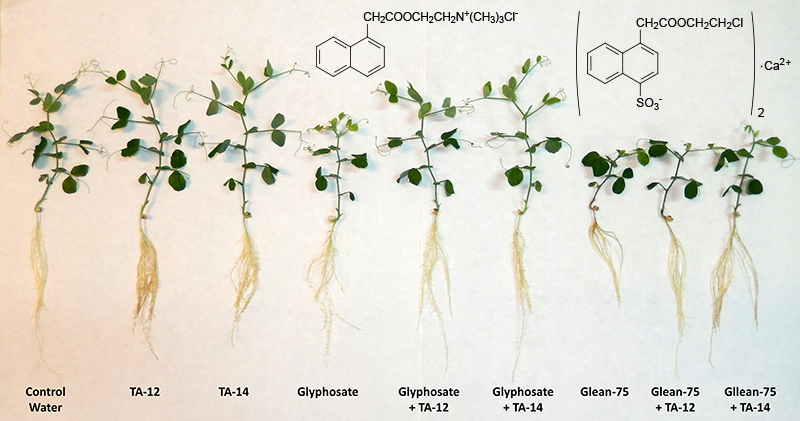
Phenotypic changes of 28-day-old pea plants sprayed with TA-12 or TA-14 and subsequently treated with Glyphosate or Glean-75.
Sergiev et al. (2020) Biologia, 75, 1845-1853
The protective effect of β-monomethyl ester of itaconic acid (MEIA) against UV-B radiation has been proven in tomato. After UV-B treatment typical phenotypic alteratons, such as drying and wilting of the leaves, were observed in tomato cv. Ailsa Craig and its anthocyaninless isogenic line ah (anthocyaninless of Hoffman). These effects were more pronounced in the anthocyaninless mutant ah. Pre-treatment of MEIA reduced the negative effects of UV-B, and the positive effects of MEIA was significantly stronger in ACr genotype.
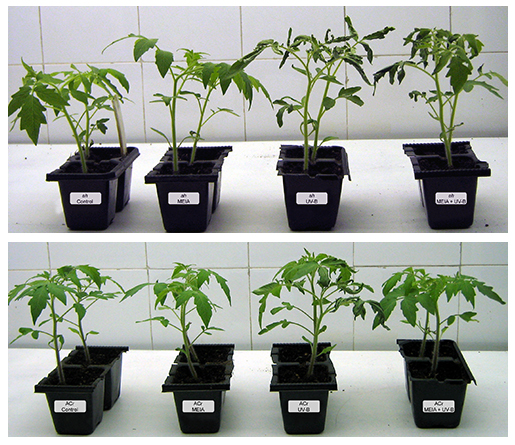
Phenotypic changes of ACr and ah tomato plants preliminary treated with 1 mM β-monomethyl ester of itaconic acid (MEIA) and irradiated with 12.8 kJ m−2 day−1 UV-B light at the 48th hour after irradiation.
Katerova et al. (2014) Compt. Rend. Acad. Bulg. Sci., 67(4), 533-540
It was found that foliar treatment with the polyamine spermine reduced the adverse effects of soil salinity in young plants of Salvia officinalis L. Salinity provoked inhibition of sage growth, accompanied by a loss of turgor and reduction of rosemarinic and carnosic acids. Pre-treatment with spermine reduced the effects of salinity on the measured parameters and increased the content of the secondary metabolites studied.
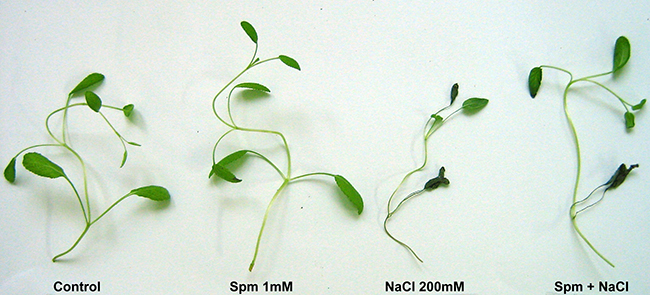
Effects of spermine (Spm), NaCl and combination of them on Salvia officinalis L.
Todorova et al. (2020) Compt. Rend. Acad. Bulg. Sci., 73(6), 800-808
We studied the effects of plant growth regulators with different mechanisms of action – phenylurea cytokinin (4PU-30), retardant (MEIA, β-monomethyl ester of itaconic acid) and triacontanol (TRIA, higher aliphatic alcohol) – on young tomato and pepper plants, infected with Tomato spotted wilt virus (TSWV). The treatment with plant growth regulators was performed before or after virus infection. The level of TSWV infection was quantified by DAS-ELISA. MEIA was found to inhibit the development of TSWV infection in two tomato lines Keti and VK1, while 4PU-30 was effective only in the Keti line, which is more sensitive to TSWV than the VK1 line. TRIA reduced the optical density of TSWV, and its effect was better when applied before infection.
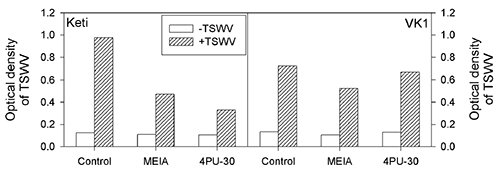
Effects of MEIA and 4PU-30 on the optical density (ОD) of TSWV, represented by the average extinction values for TSWV in non-infected (–TSWV) and infected (+TSWV) with TSWV tomato lines “Keti” and VK1.
Moskova et al. (2020) Compt. Rend. Acad. Bulg. Sci., 73(11), 1535-1544
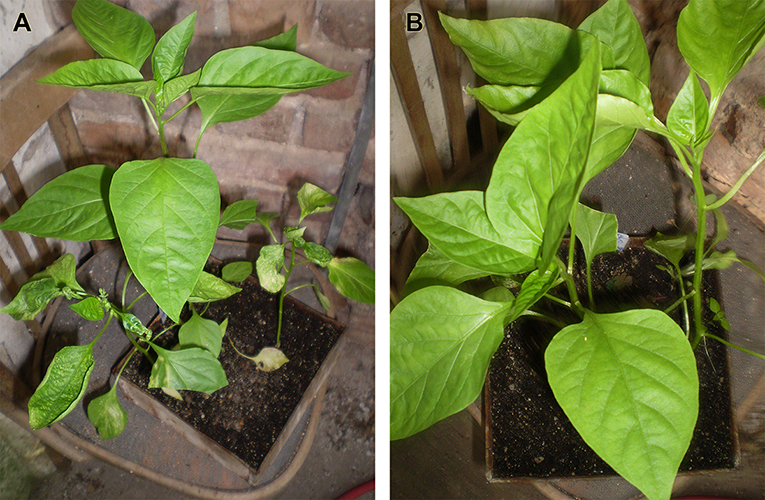
Effects of Tomato spotted wilt virus (TSWV) and triacontanol (TRIA) on pepper plants: A – infected with TSWV. Two infected plants and one healthy plant are shown. B – effects of TRIA on infected pepper plants.
Moskova et al. (2021) Compt. Rend. Acad. Bulg. Sci., 74(7), 1089-1095
Development of innovative in vitro models based on biotechnology and bioinformatics and their use in studying the action of regulators of growth and development of plants under normal and stress, to increase productivity, to stimulate the biosynthesis of secondary metabolites for nutraceutics, to preserve gene pool by conserving rare and endangered species.
In vitro cultures of important agricultural, medicinal and aromatic plants were obtained through developed protocols for regeneration, micropropagation and long-term callus and organogenic cultures of pea, soybean, Arnica montana L. (mountain arnica), Sideritis scardica Gris (Mursal tea), Rhodiola rosea L. (golden root), Rhodiola kirilowii (Regel) Maxim., Melissa officinalis L. (balm), Crocus sativus L. (saffron crocus) and others. Their ability to synthesize substances with antioxidant and protective properties has been proven. The developed in vitro technologies could find application for the production of plants for commercial purposes and sustainable conservation of endangered species.
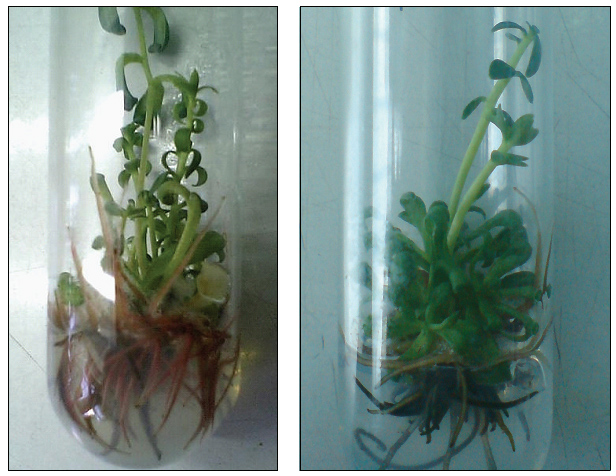
Induced rhizogenesis and propagation in Rhodiola rosea regenerated plants on MS medium enriched with 2.0 mg/L IBA, 0.2 mg/L IAA, and 0.4 mg/L GA3.
Tasheva & Kosturkova (2010) Cent. Eur. J. Biol. 5(6), 853-863
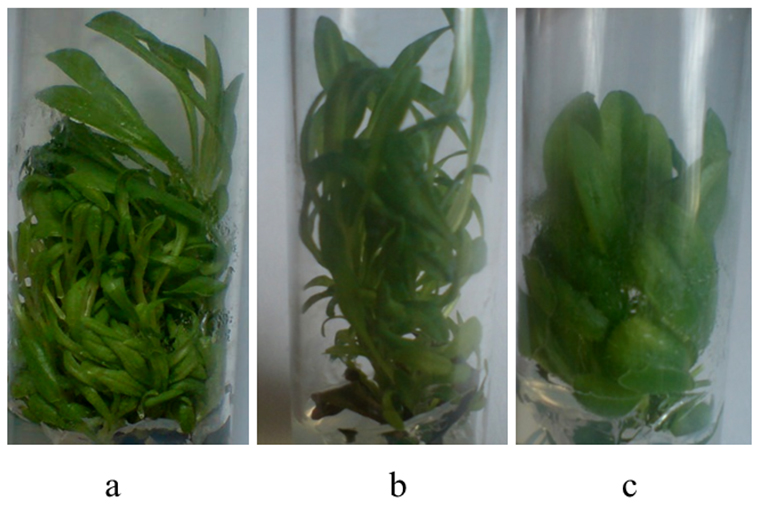
Multiplied Shoots Developed on MS Medium with Different Composition: а) MS + 1mg/l BAP и 0.1 mg/l IAA; b) MS + 1mg/l Zeatin и 0.1 mg/l IAA, b) MS + 1mg/l 2-iP и 0.1 mg/l IAA.
Petrova et al. (2021) Agric. Consp. Sci., 86(1), 57-65

In vitro rooting and acclimatization of Arnica montana: a) In vitro rooting of A. montana on ½ MS with 0.5 mg/l IBA; b) Ex vitro adapted plants; c) Plants cultured in the experimental fiеld “Beglika”; d) Three-year old plants during flowering stage.
Petrova et al. (2021) Agric. Consp. Sci., 86(1), 57-65
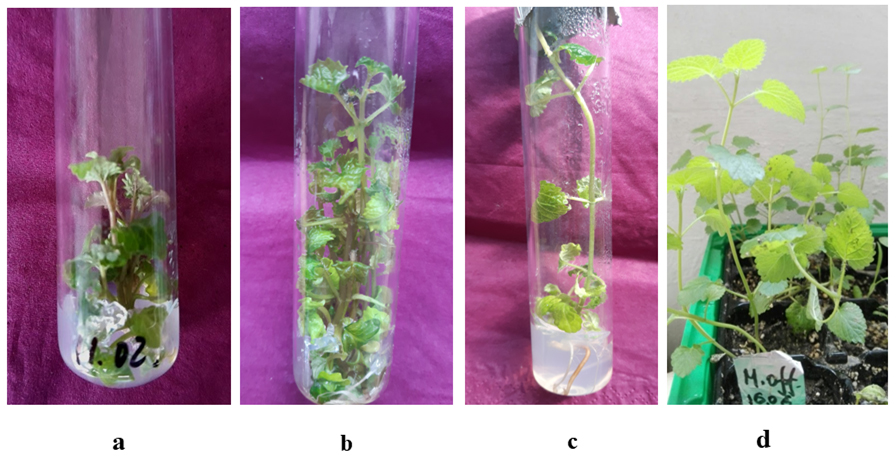
In vitro cultivation of Melissa officinalis: Micropropagation on MP3 medium (MS supplemented with 1.5 mg/L BAP and 0.5 mg/LNAA:a) first subculture) and b) second subculture; c) In vitro rooting on ½ MS nutrient medium; d) Ex vitro adapted plants.
Petrova et al. (2021) J. Microbiol. Biotechnol. & Food Sci., 11(3), e4077
